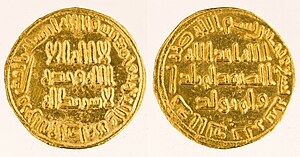
Back الوليد بن عبد الملك Arabic ولید بن عبدالملک AZB প্রথম আল-ওয়ালিদ Bengali/Bangla Al-Walid I Catalan Al-Valíd I. Czech Al-Walid 1. Danish Al-Walid I. German ވަލީދު ބިން ޢަބުދުލް މަލިކް DV Ουαλίντ Α΄ Greek Al-Ŭalid la 1-a Esperanto
| |||||
|---|---|---|---|---|---|
 Gold dinar of al-Walid, minted in Damascus, 707/08 CE | |||||
| 6th Caliph of the Umayyad Caliphate | |||||
| Reign | 9 October 705 – 23 February 715 | ||||
| Predecessor | Abd al-Malik | ||||
| Successor | Sulayman | ||||
| Born | c. 674 Medina, Hejaz, Umayyad Caliphate | ||||
| Died | (aged c. 41) Dayr Murran, Syria, Umayyad Caliphate | ||||
| Burial | Bab al-Saghir or Bab al-Faradis, Damascus | ||||
| Spouses |
| ||||
| Issue | |||||
| |||||
| House | Marwanid | ||||
| Dynasty | Umayyad | ||||
| Father | ʿAbd al-Malīk | ||||
| Mother | Wallāda bint al-ʿAbbās ibn al-Jazʾ | ||||
| Religion | Islam | ||||
Al-Walid ibn Abd al-Malik ibn Marwan (Arabic: الوليد بن عبد الملك بن مروان, romanized: al-Walīd ibn ʿAbd al-Malik ibn Marwān; c. 674 – 23 February 715),[a] commonly known as al-Walid I (Arabic: الوليد الأول), was the sixth Umayyad caliph, ruling from October 705 until his death in 715. He was the eldest son of his predecessor, Caliph Abd al-Malik (r. 685–705). As a prince, he led annual raids against the Byzantines from 695 to 698 and built or restored fortifications along the Syrian Desert route to Mecca. He became heir apparent in c. 705, after the death of the designated successor, Abd al-Malik's brother Abd al-Aziz ibn Marwan.
Under al-Walid, his father's efforts to centralize government, impose a more Arabic and Islamic character on the state, and expand its borders were continued. He heavily depended on al-Hajjaj ibn Yusuf, his father's powerful viceroy over the eastern half of the caliphate. During his reign, armies commissioned by al-Hajjaj conquered Sind and Transoxiana in the east, while the troops of Musa ibn Nusayr, the governor of Ifriqiya, conquered the Maghreb and Hispania in the west, bringing the caliphate to its largest territorial extent. War spoils from the conquests enabled al-Walid to finance impressive public works, including his greatest architectural achievement, the Great Mosque of Damascus, as well as the al-Aqsa Mosque in Jerusalem and the Prophet's Mosque in Medina. He was the first caliph to institute programs for social welfare, aiding the poor and handicapped among the Muslim Arabs of Syria, who held him in high esteem.
His reign was marked by domestic peace and prosperity and likely represented the peak of Umayyad power, though it is difficult to ascertain his direct role in its affairs. The balance al-Walid maintained among the elites, including the Qays and Yaman army factions, may have been his key personal achievement. On the other hand, the massive military expenditures of his rule, as well as his extravagant grants to the Umayyad princes, became a financial burden on his successors.
- ^ Gordon et al. 2018, p. 1001.
Cite error: There are <ref group=lower-alpha> tags or {{efn}} templates on this page, but the references will not show without a {{reflist|group=lower-alpha}} template or {{notelist}} template (see the help page).